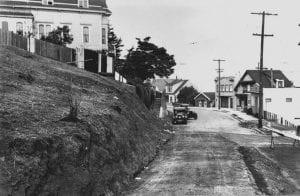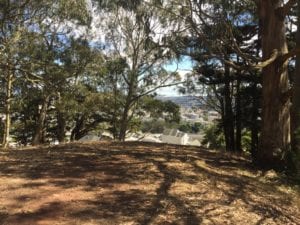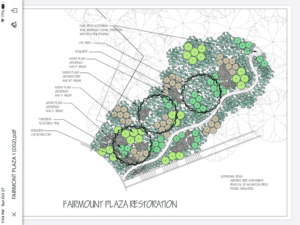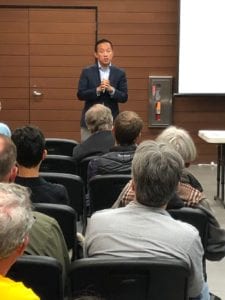
Here’s a summary of what you saw and heard, or missed, at the Glen Park Rec Center on October 17, 2019.
Halloween Street Closure:
Ingleside Station’s Tom Hauscarriague presented the plan for closure of part of Chenery Street on Halloween. Read about it in this separate post:
https://www.glenparkassociation.org/get-ready-for-chenery-street-closure-on-halloween/
Fairmount Plaza:
Word had recently gotten around the neighborhood that a small park was in the works, located at the Everson Street cul-de-sac in the area known as Fairmount Heights. The news generated a lot of interest (and rumors) and so a representative from Rec and Park was invited to explain the project.
But first, Evelyn Rose, founder of the Glen Park Neighborhoods History Project (GPNHP), gave a tantalizing slide presentation detailing the history of the Fairmount Homestead.
Rose has contributed the following account for these notes:
“The land was first surveyed in 1862 as the Pacific Railroad Homestead Association. The land was rebranded in 1864 as Fairmount, and lots were sold by an auction company around the same time the San Francisco-San Jose railroad linked the area with downtown.

Photo: SFPW, courtesy C.R. collection
The Fairmount name appears to be linked with Hyde Park, Massachusetts, the southernmost neighborhood of Boston. Hyde Park grew from a district known as Fairmount that, according to some sources, was the first suburban speculative housing development in the United States. Several men associated with the Pacific Railroad Homestead Association were pioneers from the Boston area, e.g., Richard Chenery, arriving in 1849; James Laidley, whose name first appears in local newspapers in 1851; and Charles Cook Bemis, arriving in 1858 — the namesakes of some of today’s Fairmount street names. Some of the streets were also named after locations in the Boston area, such as Arlington and Beacon. Lastly, Boston’s Fairmount was also the site of Camp Meigs, where horsemen assembled by San Franciscans living in the Boston area traveled to the East Coast to join the Massachusetts Second Cavalry as the California Hundred. It’s also the training site for the first African American unit, the 54th Regiment Massachusetts Volunteer Infantry, that was assembled in 1861 and became the subject of the movie, Glory. So, at the height of the Civil War, San Francisco’s Fairmount likely provided an association for the pioneers from Boston between events in their homeland and Union efforts during the war.
For those interested in all the fascinating details of the oldest part of Glen Park and one of the oldest neighborhoods in San Francisco, the GPNHP periodically gives historic tours of Fairmount Heights as well as Glen Park, Glen Canyon Park, Sunnyside, and Diamond Heights. Check their website for details, www.glenparkhistory.org.”

Armed with the historical facts, the group was primed for Nathan Tinclair, of SF Rec and Park’s partnership team. Tinclair described an upcoming project involving a small natural area at the terminus of Everson Street. Neighbors have spent ten years working to beautify and clean up this open space, which has often been a dumping ground. It’s hoped, indeed required, that neighbors will be the stewards of the new park.

The surrounding area is ¾ of an acre; however, the park improvement area will be ¼ acre of that area.
An anonymous donor has contributed $100,00 to realize the vision of beautification and native plant and habitat restoration. Aspects of the project also include a water connection for drip irrigation, a park trail with a map, and accessibility features.
One of the elements that has already raised some hackles is the removal of seventeen eucalyptus trees. These have been deemed to be in poor condition by a certified arborist, but suspicions remain among some tree watchdogs. Larger healthy trees will receive maintenance. Volunteers will work on additional plantings in December.
Legislative update from State Assembly member David Chiu:

- Housing and homelessness: Chiu is the chairman of the Housing Committee in the Assembly. (Scott Wiener is the chairman of the State Senate committee.) The Assembly passed its strongest renter’s protection to date, authored by Chiu It caps rent increases at the consumer price index plus five percent, which equates to eight percent. It covers an additional forty percent of dwellings built after 1979 which were not previously under rent control. It also protects renters from unfair evictions.
- Land use: Thousands of decisions are made in municipalities in the Bay Area that affect San Francisco. For example, Brisbane wanted a development that would provide four thousand jobs but refused to build additional housing. Cupertino, a city with a lot of job growth, claims their workers “live all over the place,” and so takes no responsibility for housing them. North Berkeley refused housing development in a parking lot parcel. Chiu is proposing the first major regional approach to housing with revenue measures for affordable housing; and set asides of a record $2-1/2 billion to address the homeless problem.
- Transportation: Regional Measure 3 is aimed at congestion management by bolstering the BART, Muni and Caltrain transit systems. It also focuses on water transit, e.g., ferries, which is a clean and economical mode of transportation. For pedestrian safety Chiu is striving for automated speed enforcement. A bill has been pending for two years and he is trying to move it ahead.
- Education: San Francisco has a huge number of homeless students. Among City College students, ten percent are poorly housed. There is a new emergency financial aid program for housing students in need. Governor Newsom has endorsed the proposal that graduates have diplomas which match their gender identity.
- Politics: The state is spending forty percent of its legal bills defending against policies of the Trump administration. Three lawsuits are to protect reproductive rights. One law went into effect in 2015 but is having to be defended based on its constitutionality. A lawsuit against Trump about the citizenship question on the 2020 census has been tossed out. Federal funding to states depends on an accurate count of persons living in the state. Undercounting could mean billions of dollars in funding to California. California is a donor state, meaning funds are taken from our state and given to poorer states. Another issue making its way through the courts is emissions control; California has had a higher standard for gasoline emissions than the federal government. This has cleaned up the air significantly in recent decades. On these many issues, “We win more often than we lose,” said Chiu.
A wide range of topics was covered in the Q and A. Among them:
Q: Where is affordable housing being built?
A: Affordable housing is for those earning less than eighty percent of the area median income. Units can be a portion of market rate projects, or the developer can put money into a pot for other developers. It makes for economic diversity. Affordable units are not cheap. All types of housing are expensive to build. One thing contributing to the high cost are impact fees set by the city. Many cities jack up the fees because they don’t want to build housing. Next year we hope to rationalize fees for cities. Affordable housing is allowed to be denser than other projects in order to lower costs. In-law units can be legalized as long as the footprint or character is not changed. But fees were running $50-000 to $100,000. Some legislation has brought down the fees. One aspect of housing that needs to be addressed is the “missing middle.” Affordable housing policy and market rate housing address both ends of the economic spectrum, but the state doesn’t have a policy to address those with 160% of the area median income who need the buy or rent housing. The discussion on this issue is stuck in Sacramento.
Q: What’s going on with PG&E?
A: There have been bills in the last couple of years to force them to be proactive to prevent wildfires. Now they’re saying they will be selectively shutting power down for five days. San Francisco is the only county in the nine-county Bay Area that has not yet been impacted. The shutdowns have caused billions of dollars in economic loss and have endangered people with special medical needs. We need to set government standards for power shut-offs and make PG&E pay for the effect on human lives. Mayor Breed has offered to buy PG&E’s assets but PG&E has so far refused.
Q: Will San Francisco establish its own public bank?
A: Not surprisingly, San Francisco banks with Wall Street banks, who manage $10 billion in assets of the city every year. There’s been a decades-long movement to let local jurisdictions establish their own banks for community benefit rather than value for shareholders. State approval was needed for this, and Governor Newsom signed a bill introduced by Chiu that allows the city to apply for a public bank. The Board of Supervisors will be engaging with communities on this issue.
Q: Why aren’t our housing plans based on a transportation – why is there a disconnect?
A: We have a policy of transit-oriented development of housing; that is, housing near transit or job rich areas. BART is in favor of having mixed use development around its stations. Recently they’ve approved ten acres of housing on one of their surface parking lots. This has been controversial at the regional level.